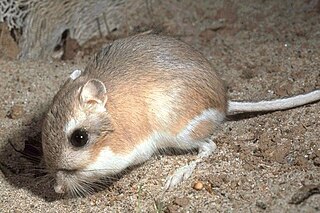
Heteromyidae is a family of rodents consisting of kangaroo rats, kangaroo mice, pocket mice and spiny pocket mice. Most heteromyids live in complex burrows within the deserts and grasslands of western North America, though species within the genus Heteromys are also found in forests and their range extends down as far as northern South America. They feed mostly on seeds and other plant parts, which they carry in their fur-lined cheek pouches to their burrows.

Dipodomyinae is a subfamily of heteromyid rodents, the kangaroo rats and mice. Dipodomyines, as implied by both their common and scientific names, are bipedal; they also jump exceptionally well. Kangaroo rats and mice are native to desert and semidesert ecosystems of western North America from southern Canada to central Mexico. They are generally herbivorous foragers, and dig and live in burrows.

Geomyoidea is a superfamily of rodent that contains the pocket gophers (Geomyidae), the kangaroo rats and mice (Heteromyidae), and their fossil relatives.

Perognathinae is a subfamily of rodents consisting of two genera of pocket mice. Most species live in complex burrows within the deserts and grasslands of western North America, They feed mostly on seeds and other plant parts, which they carry in their fur-lined cheek pouches to their burrows.

The spiny pocket mouse is a species of rodent in the family Heteromyidae and order Rodentia. It is found in Baja California in Mexico and in Arizona, California and Nevada in the United States.
The agile kangaroo rat is a species of rodent in the family Heteromyidae. It is endemic to southern California in the United States.

Heteromys is a genus of rodents in the family Heteromyidae, commonly known as spiny pocket mice. It is the only extant genus in the subfamily Heteromyinae which also includes the extinct genera Diprionomys and Metaliomys. Heteromys was recently enlarged by inclusion of the members of formerly recognized heteromyine genus Liomys, which was found to be paraphyletic.
Goldman's spiny pocket mouse is a species of rodent in the family Heteromyidae. It has been reported to be a subspecies of Heteromys desmarestianus. It is found in Guatemala and Mexico. Its natural habitat is subtropical or tropical moist lowland forests. It is threatened by habitat loss.

The Panamanian spiny pocket mouse, also known as Peter's spiny pocket mouse, is a species of heteromyid rodent endemic to Panama. It is very closely related to Salvin's spiny pocket mouse, and has been placed in the same species group by some authors. It was formerly placed in the genus Liomys, which is now recognized to be paraphyletic and has been subsumed into Heteromys.

The Mexican spiny pocket mouse is a species of rodent in the family Heteromyidae. It is native to Mexico and Texas in the United States where it is found in dry, scrubby habitats. The IUCN has assessed it as being of "least concern". It was formerly placed in the genus Liomys, which is now recognized to be paraphyletic and has been subsumed into Heteromys.
The painted spiny pocket mouse is a species of rodent in the family Heteromyidae. It is found in Mexico and the northern tip of Guatemala. It was formerly placed in the genus Liomys, which is now recognized to be paraphyletic and has been subsumed into Heteromys.

Salvin's spiny pocket mouse is a small to medium-sized rodent in the family Heteromyidae. It was formerly placed in the genus Liomys, which is now recognized to be paraphyletic and has been subsumed into Heteromys.
The Jaliscan spiny pocket mouse is a species of heteromyid rodent endemic to Mexico. The specific name spectabilis means "striking", and refers to the animal's relatively bright coloration. It was formerly placed in the genus Liomys, which is now recognized to be paraphyletic and has been subsumed into Heteromys.
The Paraguaná spiny pocket mouse is a South American species of rodent in the family Heteromyidae. It is known from two localities at elevations above 200 m, Cerro Santa Ana and the Fila de Monte Cano, within the Paraguaná Peninsula in Venezuela. While this region consists mostly of arid shrublands, this pocket mouse is found in elevated areas that provide cloud forest or mesic habitat with evergreen and semideciduous vegetation, such as terrestrial bromeliads. It is more likely to be found near streams. The species is threatened by habitat degradation due to goat grazing and development.
The Ecuadoran spiny pocket mouse is a species of rodent in the family Heteromyidae. It is endemic to central western Ecuador, where it is found at elevations from sea level to 2000 m on the coastal plain and western slopes of the Andes. The species is nocturnal and lives in dry tropical evergreen forests of the southernmost extension of the Choco; it creates well-defined runways, and is often found near streams. It is threatened by deforestation and fragmentation of its remaining habitat.
Spiny pocket mice may refer to various rodent species of the family Heteromyidae of southern North America and northwestern South America:







